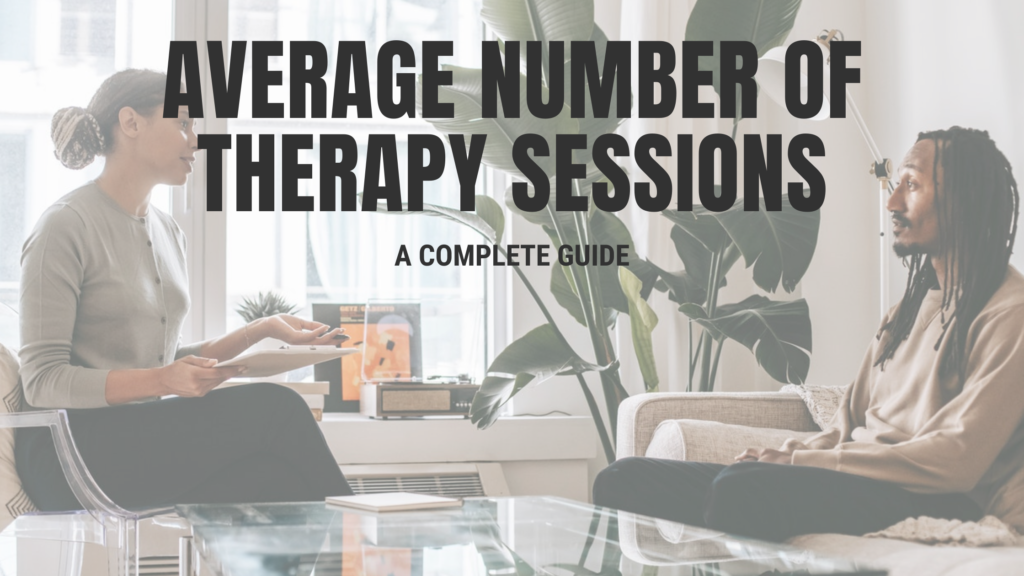So, you’re considering therapy. However, like most people looking for therapy, you’re unsure of how long treatment will take. You have multiple questions running through your mind. These include:
- How many therapy sessions will you need?
- Will you have to attend therapy for the rest of your life?
- How do you know it’s time to end a therapy relationship?
Today’s article aims at answering these questions. Using research evidence, we answer the age-old question on the average number of therapy sessions required to achieve meaningful change.
Here’s what you’ll learn.
Let’s get right into it.

What is the Average Number of Therapy Sessions Based on Treatment Type?
One of the first things that’ll determine how many therapy sessions you’ll need is the type of treatment your therapist chooses. Some examples of treatments you’re likely to encounter during therapy include:
Solution-Focused Brief Therapy
Solution-focused brief therapy is a counseling approach that helps clients build solutions for the future rather than focusing on the past.
Like the name suggests, brief therapy is time-limited, with the average number of sessions ranging from one session to 40 sessions. When using brief therapy, your therapist is usually active, with one of the main goals being the termination of treatment—the sooner a solution is found, the better.
Related: 12 Principles Of Cognitive Behavior Therapy
Cognitive Behavioral Therapy
This is perhaps one of the most commonly used therapy treatments out there. With CBT, the client and therapist work together to change the client’s behaviors. This is done by identifying limiting thoughts and replacing them with better and more helpful thoughts.
You’ll need 12 to 20 therapy sessions to see changes from CBT treatment, with each lasting 30-60 minutes.
Eye Movement Desensitization and Reprocessing (EMDR)
EMDR is a relatively new therapeutic approach used to help people heal from emotional distress caused by life experiences.
EMDR is unique since it doesn’t rely on the traditional talk therapy methodology. Instead, this treatment approach encourages the patient to practice rapid rhythmic eye movements, which reduces the power of emotional thoughts caused by past trauma.
With EMDR, some patients start noticing drastic changes after three sessions. On average, it takes 6-12 sessions for most people to process and deal with these traumas.
Related: What Kind Of Therapy Do I Need – 7 Types Easy Explained
Motivational Enhancement Therapy
Often used for people struggling with addiction, motivational therapy is one of the shortest psychotherapy treatments.
With motivational therapy, the counselor helps clients find the internal motivation to drive lasting changes. Typically, motivational counseling requires an average of four sessions.
Psychoanalysis
This is probably the therapy technique most seen in movies. With psychotherapy, you and your therapist explore past experiences, including trauma and repressed memories.
Psychoanalysis mainly focuses on the unconscious mind. Due to the vast nature of the subconscious, psychoanalysis therapy sessions usually last for years.

Average Number of Therapy Sessions Based on Problems
Now that you know the average number of sessions for the most common therapy approaches, let’s get into how many sessions you’ll need for different mental health issues.
How Many Therapy Sessions for Anxiety?
Anxiety disorders are among the most common mental health problems that therapists work with. If you suffer from panic attacks, debilitating phobias, OCD, or unrelenting worries, you should consider seeking a therapist’s help.
However, like most people, you’re curious about how long it will take to see lasting changes.
According to a 2005 study, there’s no optimum number of sessions for anxiety disorders. Based on the research, treatment outcomes improve with more therapy sessions. However, according to the APA, most people start seeing significant changes in anxiety symptoms after 8-10 therapy sessions.
Related: 31 Best Cognitive Behavioral Therapy (CBT) Books
How Many Therapy Sessions for Depression?
Psychotherapy is one of the most effective methods for treating depression. In some instances, therapy has been touted to be more effective than the use of antidepressants.
But how long does it take for therapeutic treatment for depression to work?
According to the study mentioned earlier, it takes 6-8 therapy sessions for notable improvements to get noticed. Unlike anxiety disorders, which get better with more therapy sessions, depression doesn’t need many sessions. More than eight sessions don’t seem to offer any additional benefits.
How Many Therapy Sessions for PTSD?
PTSD is another common problem that therapists often deal with.
With PTSD, most therapists will opt to use CBT methodologies for treatment. In general, it takes an average of 10-20 sessions for CBT to work.
So, for PTSD, you may need approximately 15-20 therapy sessions to feel a substantial improvement.
How Long Does Couples Therapy Take?
Also known as marriage counseling, couples therapy aims to help couples recognize and resolve conflicts, therefore improving their relationship. However, like most, people seeking couples counseling always ask how many sessions they’ll have to come in.
For couples with minor issues such as improving communication and dealing with finances, it takes between 4-6 sessions to notice meaningful changes.
However, you may need approximately 12-16 sessions with a professional marriage counselor for more complex issues.

Are There Problems That Need More Therapy Sessions?
Yes!
While therapy comes to an end on most occasions, people with severe mental health problems may need more treatment sessions. This includes people with cooccurring conditions and those with personality disorders.
On average, treatment for such conditions takes 12-18 months.
Some may need lifelong therapy. These are people with chronic conditions that require maintenance therapy to make sure the condition doesn’t recur.
However, if you don’t suffer from the above conditions and are still in therapy after 12 months, you may be a victim of this next point.
Related: How Is Behavior Therapy Different Than Psychoanalysis
Is it Possible to Become Dependent on Therapy?
Yes.
Some people struggle with therapy addiction. On most occasions, these people are hesitant to stop therapy due to a fear of relapsing back to their problems.
However, that shouldn’t be the case. Therapy is meant to end at one point—unless you suffer from a chronic mental health condition.
On most occasions, therapy addiction isn’t the patient’s fault but rather the therapist’s fault. This is because a therapist’s primary role is to train the client to stand on his/her feet without external help.
If a patient doesn’t respond to one treatment method, the therapist should change treatment or refer the patient to another therapist.
If you’re unsure if you should end therapy, here are a few signs to know when to terminate treatment.
Related: How Long Does Psychoanalysis Typically Take?
When to End Therapy
One of the first things to consider when looking to end therapy is whether your set goals were met. If you feel like your problems have been addressed, it may be time to terminate treatment. Your therapist might give you hints by prolonging the period between sessions.
Another indication that it’s time to terminate the therapist-client relationship is when you feel like some of your issues aren’t being addressed. If you feel like you still have a lot of unresolved issues, even after attending multiple sessions, then it may be time to terminate therapy.
For such a scenario, it’s advised that you seek a different therapist.
And here’s the best part.
On most occasions, breaking up with your therapists won’t be that bad. All you need to do is inform them of your intention. However, when terminating a therapy relationship, make sure to leave feedback on why you’re breaking up.
Any Further Questions?
There you go.
All you need to know about the average number of therapy sessions for different conditions and different approaches.
I hope this guide helped to make your decision on seeking therapy easier. If you have any questions or comments, please leave them in the comment section.
I’ll be happy to respond to all questions and comments sent.
If you enjoyed this information and you think it could be valuable for someone you know to study, please forward this to them.
Related Content
EMDR Therapy Near Me – A Complete Guide
